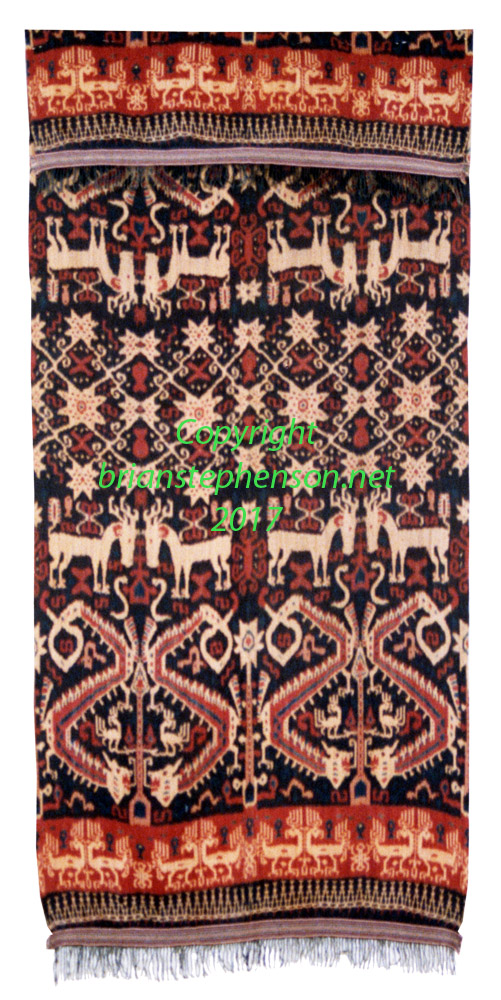Sumba Hinggi
Mouse over or tap to magnify

Details
| Item-Number: | 841206 |
| Item-Description: | East Sumba manís warp ikat shoulder or hip cloth (Hinggi) |
| Medium: | Cotton, natural dyes |
| Origin: | Lesser Sunda Islands - East Sumba |
| Dimensions: | 248 x 106 cm |
| Age: | Mid 20th century |
| Provenance: | Collected Sumba Island 1984 |
| Condition: | Excellent |
| Notes: | General: The warp ikat Hinggi from East Sumba, Lesser Sunda Islands, are some of the most beautiful and striking of tribal cloths. Worn principally by Sumba Island men from the elite and nobility as hip or more commonly shoulder cloths, they strongly reflect the male islanders concern for nature, ritual and the spirit world. Woven in combinations of natural red (hinggi kombu) and blue dyes on white or ecru, they carry a wide range of geometric, anthropomorphic and zoomorphic motifs arranged in horizontal bands, commonly three to eleven in number. The motifs are generally outlined in white or ecru. They are also woven with the upper part of the cloth being the mirror image of the lower so that when the cloth is hung over the shoulder the motifs appear the correct way up on both the front and rear. More unusually, they can also carry iconography taken from other sources such as old Chinese porcelain and Dutch coins. Woven in two vertical sections and stitched together, the central horizontal band generally carries motifs reflecting modification of the patola motif. Another major band is the hai (second above the fringe) which is often the widest and carries some of the most significant motifs of a particular cloth. Criteria for identifying high quality hinggi include, firmly woven, use of hand spun cotton, precision of the images, complexity of pattern, saturated colour tones and tan over staining, Z stitching joining of the two panels, elaborate corded and ikat patterned fringes. The number and quality of cloths owned reflects wealth and status. They are given as gifts at weddings and worn on ritual and ceremonial ocaissions. They also serve as shrouds and grave goods. Specific: This example is a very high quality Hinggi woven in black and deep rust red, with motifs outlined in ecru. The main band carries large serpents, a design probably taken from old Chinese ceramics of the Sung or Ming dynasty, and fighting cocks. Immediately above is a band showing deer. This signifies that this cloth comes from very high ranking nobility as deer could only be hunted by nobles and therefore symbolizes a chief. The central band, or Patola Ratu, is outstanding and shows numerous large eight pointed stars. |
Price on Application

